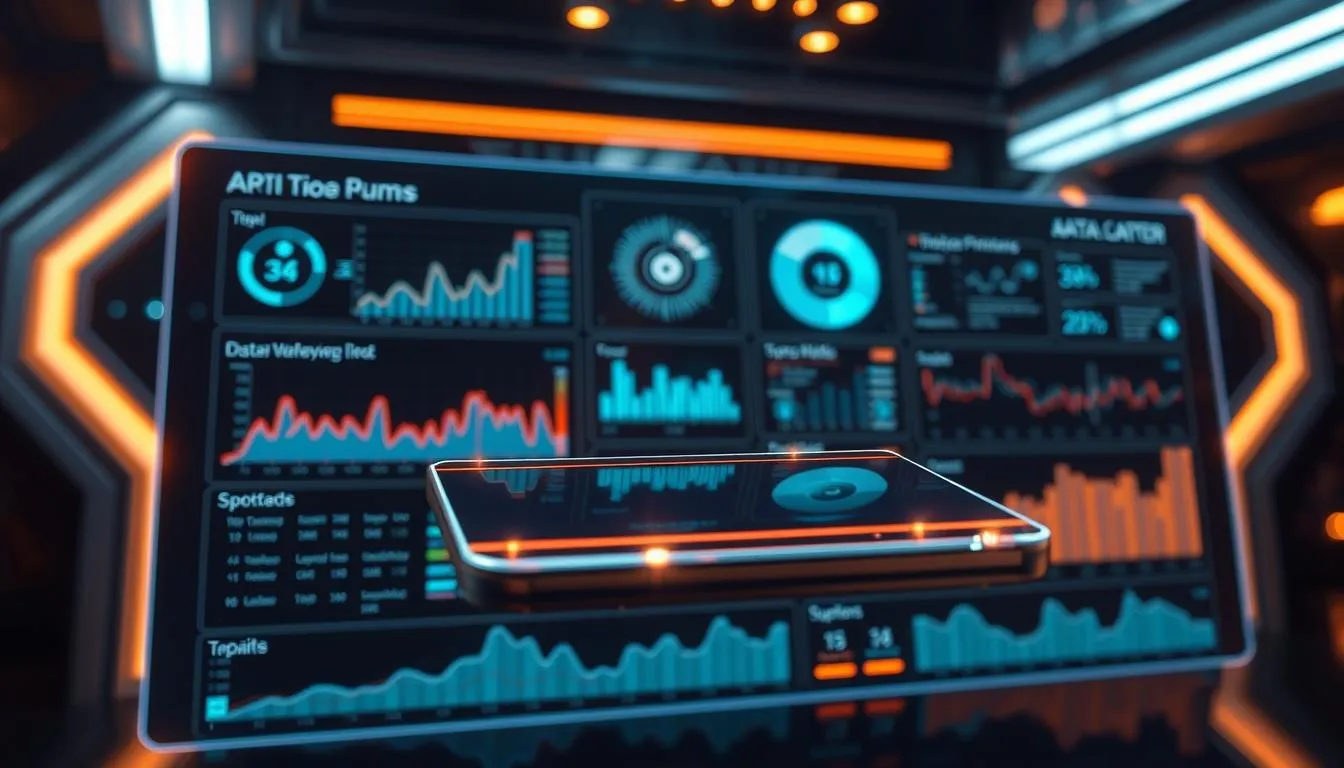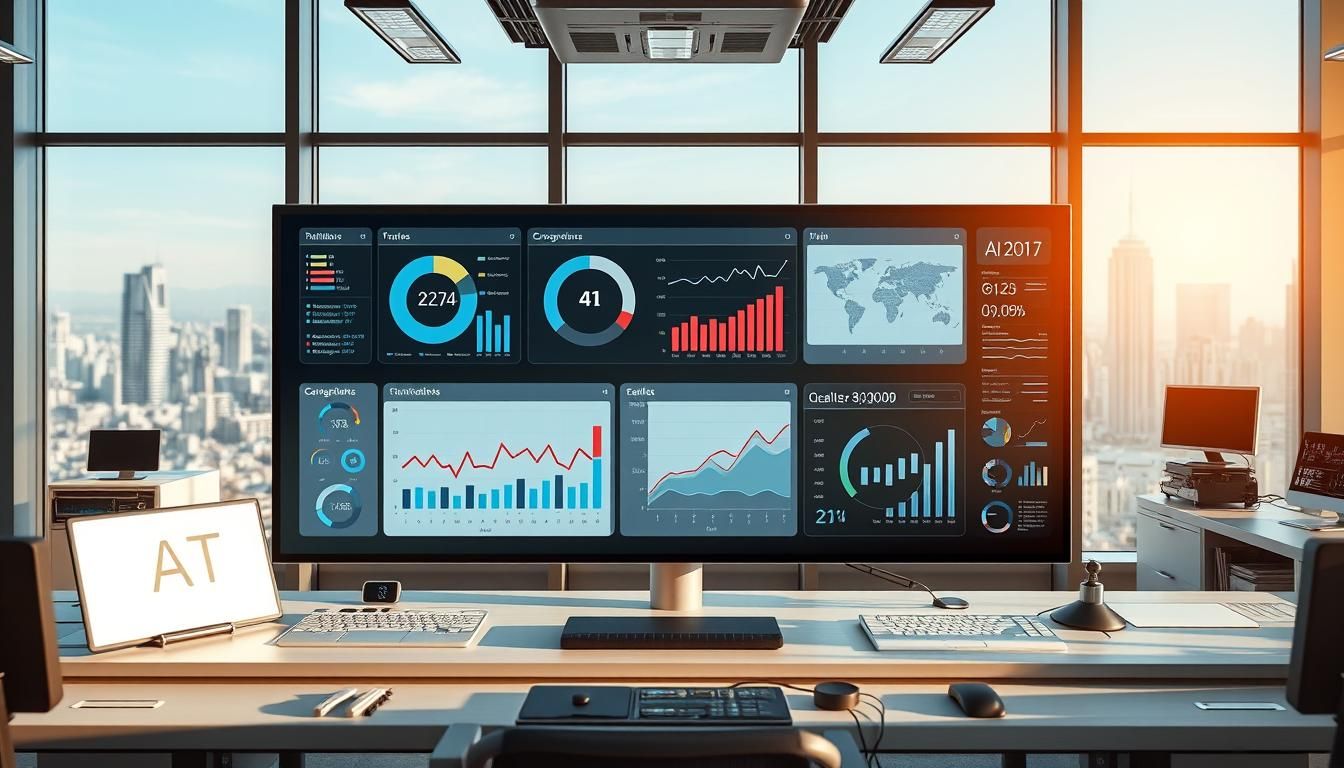Did you know companies using intelligent analytics tools see decisions made 63% faster than those relying on manual methods? This seismic shift stems from a new breed of business tools that think alongside users, turning raw numbers into actionable strategies.
Traditional reporting systems often leave teams drowning in spreadsheets. Modern solutions now interpret questions like “Show sales trends by region” and instantly generate visual charts. These platforms learn from every interaction, refining their ability to highlight opportunities or risks before they become obvious.
What makes these systems revolutionary? They combine evolving business intelligence tools with adaptive algorithms that predict what information matters most. Instead of static tables, you get dynamic interfaces that adjust layouts based on real-time priorities.
This transformation isn’t just about speed—it’s about accessibility. Non-technical staff can now explore complex patterns through simple conversations with their analytics dashboard. As noted in recent Forbes research, organizations adopting these methods report 40% fewer missed opportunities due to delayed insights.
Key Takeaways
- Static reports evolve into interactive systems that anticipate user needs
- Natural language queries replace complex filtering processes
- Machine learning optimizes how information gets presented
- Technical and non-technical users gain equal access to insights
- Real-time adaptation creates competitive advantages
Understanding AI’s Role in Data Visualization
Remember when pie charts felt revolutionary? Today’s systems transform raw numbers into dynamic stories. Early visualization required coding skills and hours of manual work. Now, anyone can ask questions like “Compare regional sales trends since January” and get instant answers.

The Evolution of Data Visualization
Static graphs once dominated boardrooms. Teams waited days for updated reports, missing crucial patterns. Modern solutions changed everything. They interpret natural language requests, turning complex queries into clear charts without SQL expertise.
Two breakthroughs made this possible. Natural Language Generation crafts summaries from spreadsheets, like a colleague explaining results. Natural Language Querying lets users type requests in plain English. Together, they remove technical barriers—no more deciphering database structures.
The Impact on Business Intelligence
Decisions now happen Streamline AI Data Cleaning speed of thought. Marketing teams spot seasonal trends faster. Finance groups predict cash flow shifts before quarterly meetings. These tools empower frontline staff to test ideas without IT help.
Real-time adaptation creates new advantages. A retail manager might ask, “Show products underperforming in coastal stores” during a strategy call. The system highlights issues and suggests fixes. As noted in recent analysis, companies using these methods cut reporting delays by 58%.
How to Create an AI Data Dashboard
Building smart analytics systems starts with choosing the right foundation. Modern platforms combine visual storytelling with automated pattern recognition, turning raw numbers into strategic assets. Let’s break down the essentials.

Step-by-Step Guide for Setup
First, select tools with built-in language model support. These systems interpret natural requests like “Compare quarterly revenue across product lines” and generate charts instantly. Connect your datasets through secure APIs—most platforms guide you through this with templates.
Integrating Natural Language Processing
Enable conversational queries by adding semantic layers. These translate technical terms into everyday language. For example:
- “Show top-selling regions” becomes a heatmap
- “Highlight inventory risks” triggers trend analysis
Automating Data Insights
Configure alerts for critical changes. When sales drop 15% in a region, the system can:
- Update related charts
- Email stakeholders
- Suggest corrective actions
As industry leaders note, automated systems reduce response times by 73% compared to manual monitoring.
Mastering Key AI Techniques for Interactive Analytics
Imagine asking your analytics system, “Explain last month’s revenue drop in simple terms” and receiving a detailed report with charts. Modern tools achieve this through two game-changing methods.
Conversational Insights Made Simple
Natural language features let teams ask questions like they’re talking to a colleague. Type “Show me seasonal patterns in customer returns” and watch heatmaps appear. These systems:
- Translate technical terms into plain English
- Generate summaries explaining trends
- Update visualizations as new information arrives
Seeing the Future – And Catching Surprises
Predictive models analyze past performance to forecast outcomes. A retail chain might discover:
- Holiday sales will spike 22% in the Midwest
- Warehouse stock needs adjustment by November 1st Check out our guide on Validate AI Product Idea:.
Anomaly detection spots odd patterns instantly. When shipping costs suddenly jump 40%, the system flags the issue and traces it to a new fuel surcharge. One logistics manager noted: “It’s like having a detective who works 24/7.”
Together, these methods turn raw numbers into strategic stories. Teams spend less time digging through spreadsheets and more time acting on clear signals.
Selecting the Right AI Tools and Platforms
Choosing the best analytics partner starts with understanding your team’s needs. Modern solutions range from nimble starters to enterprise-grade systems. Look for platforms that grow with your business while keeping information secure.
Comparative Analysis of Top Platforms
Leading options like GoodData stand out by blending adaptable architectures with smart features. API-first designs let teams connect preferred technologies – whether GPT-4 for text generation or Gemini for visual analysis – through simple integrations.
Key evaluation points include:
- How systems handle large datasets
- Built-in support for natural language queries
- Real-time collaboration features
Smaller teams might prioritize quick setup and pre-built templates. Larger organizations often need custom security protocols and scalability. One retail manager noted: “We switched to a modular platform last quarter – now we mix tools like building blocks.”
Ultimately, the right choice balances current needs with future flexibility. Platforms that simplify updates and new connections will keep pace with evolving business goals.
FAQ
What makes modern analytics platforms different from traditional tools?
Modern solutions use machine learning to automate insights, identify trends, and generate visual summaries. They adapt to user behavior, prioritize critical metrics, and simplify complex datasets into actionable reports without manual configuration.
How does natural language processing enhance interactive analytics?
NLP lets users ask questions in plain English, like “Show sales trends by region,” and instantly receive charts or summaries. This bridges the gap between technical analysis and business decision-making, empowering teams to explore information faster.
Can predictive models work with real-time datasets?
Yes. Advanced systems analyze live streams of information, flag anomalies, and forecast outcomes using historical patterns. For example, retail brands use These tools to adjust inventory based on shifting demand signals detected in real time.
What factors should businesses consider when choosing a platform?
Prioritize scalability, integration capabilities with existing tech stacks, and customization options. Look for features like automated anomaly detection, collaborative workflows, and support for diverse chart types to match specific operational needs.
How do automated insights reduce decision-making delays?
By instantly highlighting correlations, outliers, and trends hidden in large datasets, These tools eliminate hours of manual analysis. Teams gain clarity on priorities, allowing them to act on opportunities or risks before competitors do.
Are there industry-specific templates for visualization?
Many platforms offer prebuilt frameworks tailored for healthcare, finance, or e-commerce. These templates standardize key performance indicators, compliance metrics, and reporting formats while allowing customization for unique organizational goals.
